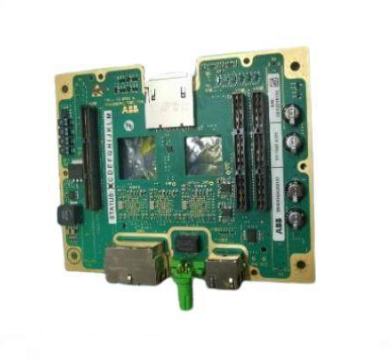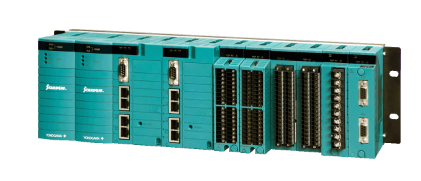ABB NIT03 is an industrial grade basic control module, belonging to the ABB AC 500 eCo series of small automation systems. Its core function is to achieve logical control, signal acquisition, and actuator drive for small and medium-sized equipment. As the "control center" of single machine equipment or small production lines, it is widely used in machine tool auxiliary control, packaging machinery, material conveying equipment, small water treatment devices and other scenarios, especially suitable for cost sensitive and simple control requirements automation projects.
ABB INIT03 Control Module
Product positioning and core values
ABB NIT03 is an industrial grade basic control module, belonging to the ABB AC 500 eCo series of small automation systems. Its core function is to achieve logical control, signal acquisition, and actuator drive for small and medium-sized equipment. As the "control center" of single machine equipment or small production lines, it is widely used in machine tool auxiliary control, packaging machinery, material conveying equipment, small water treatment devices and other scenarios, especially suitable for cost sensitive and simple control requirements automation projects.
Its core value lies in "high cost-effectiveness+streamlined functions+easy integration": integrating digital/analog processing functions with a compact structure, which can meet basic control needs without the need for additional expansion modules; Supporting standardized programming and communication protocols, with low entry barriers, suitable for quick on-site debugging; The cost is only one-third of that of high-performance modules such as HAC319AEV1, significantly reducing the investment cost of small automation projects.
Core parameters and functional characteristics
1. Key electrical and performance parameters
Processor and computing power
16 bit industrial grade processor, with a clock speed of 80MHz and a computing power of ≥ 10 MIPS, supporting IEC 61131-3 standard programming languages (LD/FBD/ST), and a maximum program storage capacity of 64KB
Signal processing interface
Digital input (DI): 12 channels, 24V DC (leakage type input, response time ≤ 10ms); Digital output (DO): 8 channels, 24V DC (source type output, maximum load of 1A per channel, short-circuit protection current of 3A); Analog input (AI): 4-channel, 4-20mA/0-10V dual range, sampling accuracy ± 0.5% (12 bit AD conversion)
Communication ability
Supports Modbus RTU (RS485 interface, communication speed adjustable from 9600-115200bps), Ethernet (optional ENET-AC module to expand Ethernet/IP); Up to 8 slave devices (such as sensors and frequency converters) can be connected
Power Supply and Storage
24V DC power supply (input range 19-30V DC), power consumption ≤ 8W, with overvoltage (32V DC protection), overcurrent (2A protection), and reverse connection protection; Onboard 8KB EEPROM (data saved in case of power failure, with a storage time of ≥ 10 years)
Environmental adaptability
Working temperature: 0 ℃ to 60 ℃, relative humidity: 5% -95% (no condensation), protection level: IP20 (module body), anti vibration performance: 10-500Hz, 0.1g (sine wave vibration), anti impact performance: 5g (11ms, half sine wave)
Security certification
Compliant with CE (EN 61131-2), UL (UL 508) safety standards, flame retardant rating UL 94 V-0, and RoHS environmental certification
2. Core functional features
Simplified integrated design: The module size is only 70mm (width) x 90mm (height) x 110mm (depth), suitable for 35mm DIN rail installation, with a 12DI+8DO+4AI interface configuration, which can directly interface with sensors and actuators of small devices (such as photoelectric sensors of packaging machines and conveyor motor contacts), without the need for additional expansion modules, reducing cabinet space occupation and wiring complexity.
Usability and fast debugging: Supports graphical programming (drag and drop logic blocks) through ABB CoDeSys programming software, allowing for basic control program writing without the need for professional programming experience; Equipped with 3 status indicator lights (power, operation, fault) and 1 reset button, the module's working status can be intuitively judged during on-site debugging, reducing the troubleshooting time to within 15 minutes.
Basic anti-interference ability: The DI input circuit integrates an RC filtering circuit (with a fixed filtering frequency of 50Hz), which can suppress high-frequency interference generated by workshop motors and frequency converters; The analog input circuit has hardware filtering function, with a sampling value fluctuation range of ≤± 0.2%, ensuring stable signal acquisition in the electromagnetic environment of small workshops.
Flexible Expansion Options: Although it is a basic module, it reserves one expansion interface that can be externally connected to AC 500 eCo series dedicated modules (such as AI-AC module to expand analog input, DO-REL module to expand relay output). When control requirements are upgraded (such as expanding from single machine control to dual machine linkage), there is no need to replace the main module, only an expansion unit needs to be added to reduce upgrade costs.
Adaptation devices and collaborative applications
1. Core adaptation equipment
Signal conversion unit
ABB TU515 terminal unit (for transferring sensor/actuator signals, suitable for simple wiring scenarios), ABB DSTF610 terminal unit (for expanding interfaces when signals are dense)
External sensors/actuators
24V DC photoelectric sensor (ABB O5 series, NPN output), travel switch (ABB LS45 series), 24V DC solenoid valve (controlling cylinder action), small indicator light (AC 220V/DC 24V)
Communication and auxiliary equipment
ABB RS485 communication cable (model 3FLA000050R0001), ordinary 24V DC power module (such as Mingwei LRS-35-24), programming cable (model USB-AC500)
Related control devices
ABB 3HAC031683-004 teaching pendant cable (indirectly linked through robot I/O module, such as material conveying and robot loading and unloading coordination), ABB HAC319AEV1 control module (substation control in large systems)
2. Collaborative application case with 3HAC031683-004 and TU515: Small packaging machine robot loading and unloading system
System architecture: It is necessary to implement the linkage control of "robot feeding → packaging machine packaging → finished product conveying", involving 2 channels of robot feeding in place DI signals, 3 channels of packaging machine status DI signals (such as missing film alarm, sealing temperature reaching standard), 2 channels of conveyor belt motor DO control signals, and 1 channel of packaging machine start/stop DO signal. Initiat03 serves as the control core of the packaging machine and conveyor belt, and 3HAC031683-004 is connected to the robot teaching pendant to achieve parameter coordination.
Connection logic:
The robot feeding in place signal (output from the IRC5 controller) and the packaging machine missing film/temperature signal are connected to the TU515 terminal unit through wires, and after TU515 conversion, they are connected to the DI channel (terminals 1-5) of Initiat03;
The operator sets the feeding frequency through the teaching pendant (connected to the robot controller via 3HAC031683-004 cable), and the robot controller transmits the feeding instruction to the Initiat03 through Modbus RTU protocol;
Initiat03 runs the logic program: When the "loading in place+temperature reaching standard" signal is detected, the DO signal is output to start the packaging machine packaging (terminal 6), and after the packaging is completed, the conveyor belt motor is triggered to run (terminal 7); If a "missing film" signal is detected, immediately stop the packaging machine and conveyor belt, and provide feedback through communication to the robot teaching pendant for alarm.
Core advantage: Initiat03 meets basic control needs with high cost-effectiveness, reducing control costs by 50% compared to using HAC319AEV1; TU515 simplifies wiring management, 3HAC031683-004 ensures parameter coordination between robots and packaging machines, and the overall system debugging cycle is shortened to one day.
Installation process and key points
Rail fixation: Installed in the middle of the control cabinet (away from the cabinet door and heat source) through a 35mm DIN rail, with a distance of ≥ 5mm from adjacent equipment (such as power modules and terminal units) to ensure heat dissipation; If there is a frequency converter in the control cabinet, the distance between it and the module should be ≥ 20cm to avoid strong interference.
Power connection: Use a 1.5mm ² copper wire to connect the "+24V" and "GND" terminals of the 24V DC power module to the module power input terminals ("L+" and "M"). Reversing the positive and negative poles will trigger internal protection (if the module is not damaged, it can be restored by reconnecting the polarity).
Signal and communication wiring:
Digital signal: Connect the DI terminal to the output signal of TU515 (or directly connect the sensor), ensuring that the sensor is grounded with the module (GND connected); DO terminals are connected to actuators (such as contactor coils), and external relays (such as ABB CR-M series) are required when the load current exceeds 1A;
Analog signal: The AI terminal is connected to a sensor (such as a pressure transmitter) through a shielded twisted pair cable, and the shielding layer is grounded at one end (module side). The cross-sectional area of the wire is ≤ 0.75mm ², and the transmission distance is ≤ 50m
Communication wiring: RS485 interface ("A" and "B" terminals) is connected to Modbus slave devices, and 120 Ω terminal resistors need to be connected at both ends of the bus (only installed at the farthest device end). The communication cable uses shielded twisted pair with a length of ≤ 100m
Programming and configuration: Connect the module's "USB" interface to the computer through a USB programming cable, open the CoDeSys software, import the basic program template (available for download from ABB's official website), modify the I/O address and logic instructions according to on-site requirements, and restart the module to take effect after downloading.

- User name Member Level Quantity Specification Purchase Date
- Satisfaction :
-









Email:wang@kongjiangauto.com




































































































































